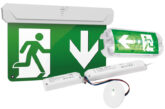
Simon Coates, Technical Manager at Orbik, offers his guidance on what you should be looking for when purchasing emergency lighting products.
“You get what you pay for”. We’ve all heard this phrase on numerous occasions and many of us can even relate it to our own personal experiences. When it comes to emergency lighting, the principles certainly apply.
Reduce the risk
So how do you guarantee that the quality of the product will not affect the safety of the customer whilst providing the commercial advantage we all strive for? The simple answer is you can’t, but there are certainly some simple steps you can take to help reduce the risk.
When selecting your product you should invest some time in researching the options available. Who manufactures the product? Most reputable companies will make it easy for you to find them and to see more about their background and heritage. Their products should lead you to them; after all, as manufacturers we should show pride in the items we produce.
Once you’ve found them you should then take time to investigate their company profile, looking for answers to the following questions:
● How long has the company been trading? Here at Orbik we’re proud of our 35-year history.
● What quality standards does the company hold? The one you should be looking for is BSI ISO 9001.
● Does the company belong to any accredited associations? For emergency lighting the two to look out for are:
1. The Lighting Industry Association (LIA);
2. The Industry Committee for Emergency Lighting (ICEL).
Both have strict criteria for membership, including either a recognisable quality-manufacturing standard or, in the case of the LIA, their own audited quality standard.
What to look out for
What about the products? That is, after all, what you’re going to be purchasing. Again, there are certain things that you should look out for.
We’ve all heard of the CE mark, but do we really know what it is? To sell a product in the UK the product must comply with the essential requirements of the relevant European Health, Safety and Environmental Legislation. All products have this mark so does it matter? Not really, but the manufacturer has a legal requirement to provide, upon request, an EC/EU Declaration of Conformity. Try asking for one, it’s easier than you think. Your supplier should be able to obtain a copy for you, or you can request one directly from the manufacturer yourself.
Willing and label
The product label must provide contact details, as this is another European requirement regarding the labelling of the product. If you can’t obtain a copy of the EC/EU Declaration of Conformity, you shouldn’t really be using the product and it shouldn’t be sold to you.
You can also look for product approvals, such as the BSI Kitemark (which we should all be familiar with) and ENEC for Europe. There are many more as well and any reputable company should be able to advise you on their symbols and what they mean.
Don’t be afraid to ask for a copy of their certificate or go to the approval board’s website directly and check for yourself.
Orbik Electronics products, for example, are available to check at: www.bsigroup.com/en-GB/Prod.
Another thing I’ve not mentioned and which should be brought to the attention of the customer is the associated product technical support. Assuming you’ve done your research and have narrowed your product selection down, you then need to decide how best to use that product. In emergency lighting there is a lot to cover and, understandably, not everyone is an expert. I have myself, a very limited knowledge of the requirements of electrical installation, but I do know people with the expertise to answer my questions.
You should have that confidence in the supplier of your product and be able to access their technical knowledge. Not only should they be able to advise you on your application, but they should also be able to provide you with the relevant supporting documentation.

In emergency lighting there is a minimum requirement of illumination to be met. One method to derive design figures for light levels is to use spacing tables, provided by the manufacturer as a guide to mounting their products in order to achieve the minimum lighting levels. If they can’t provide this basic information then you should look to someone who can.
Orbik can offer CPD accredited training on our products and general emergency lighting techniques, both here at our own purpose-built training facilities or at your premises.
Ask yourself, would you be happy to compromise the safety of yourself or even your family? Then why do it with your customer? After all, you are responsible for your actions, which could result in legal action.








